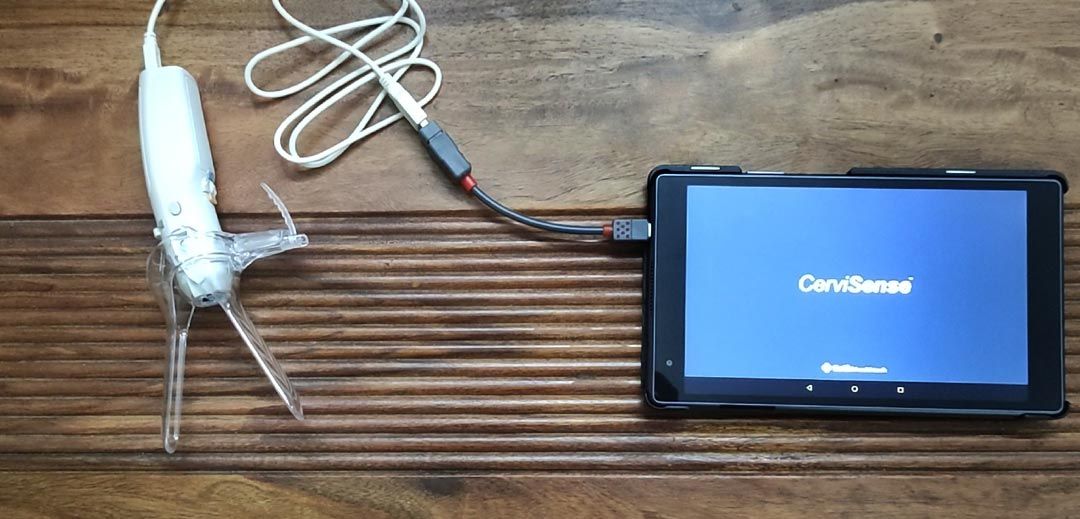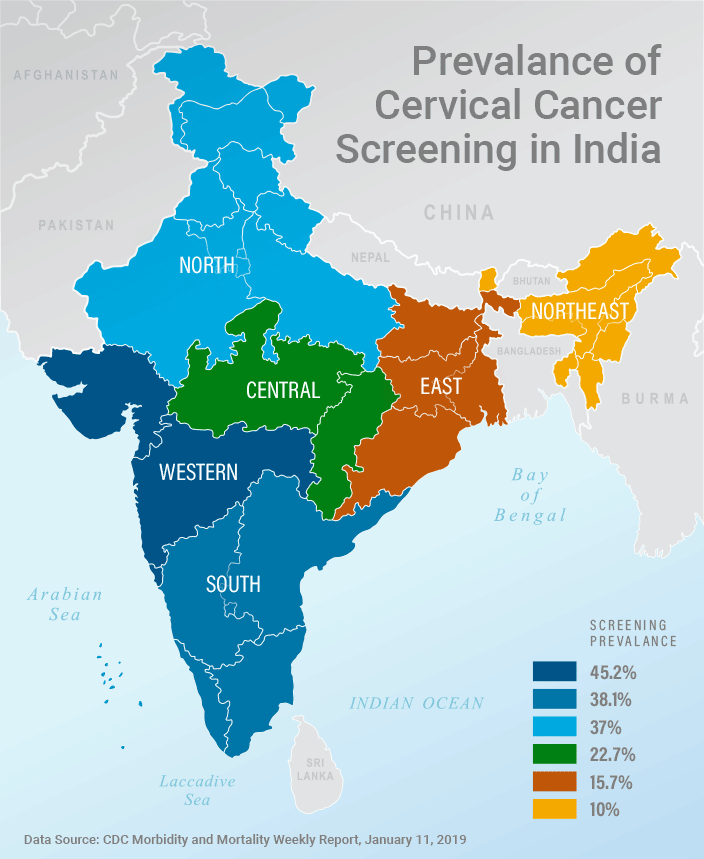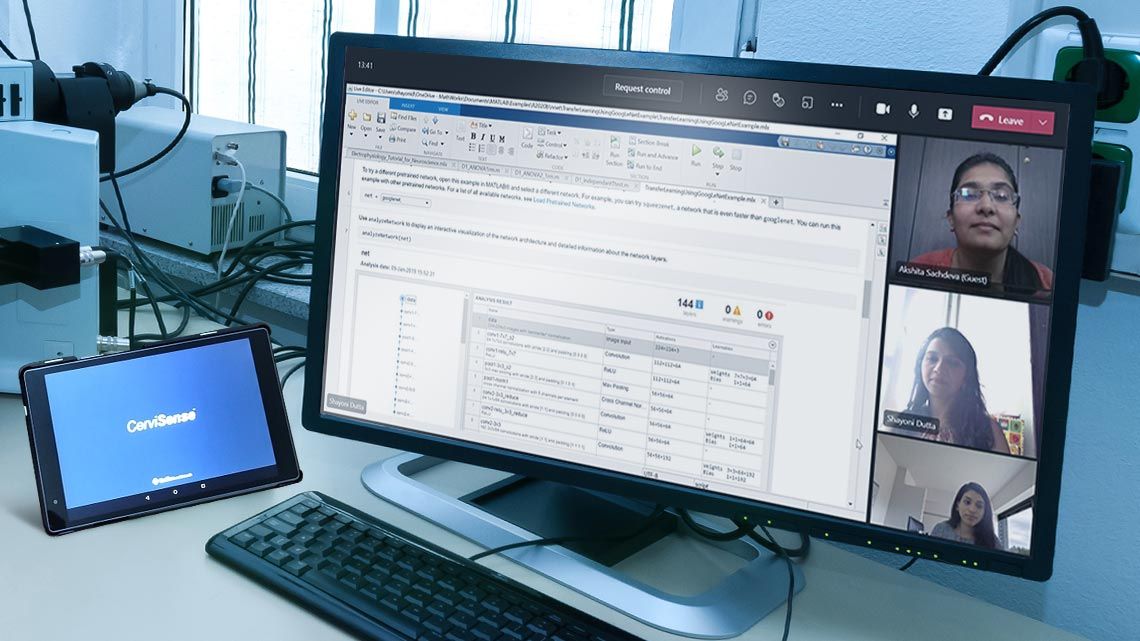Machine Learning Helps Bring Critical Cancer Screening to Rural India
Inspired by Her Family’s Story, Founder Hopes to Boost Healthcare Equity Through Tech
Akshita Sachdeva was just eight years old when her grandmother died of cancer, but the event, she says, left a mark on her. She grew up hearing her grandfather say that if there had been a physician in the family, maybe his wife wouldn’t have died from the disease.
Motivated by her personal experience, Sachdeva entered the medical device startup space. Now, she is developing an inexpensive, portable way to bring cervical cancer screening to rural communities. Looking for support for her venture, she applied to the 2020 MedTechnovation challenge from the Dayananda Sagar Entrepreneurship Research & Business Incubation Foundation (DERBI Foundation), which partnered with MathWorks for the challenge.
Equity in Cancer Screening
Intending to become the doctor her grandfather wished for, Sachdeva took medical classes during her 11th and 12th grade years. But one of her professors showed Sachdeva that there might be other ways to help people at risk of cancer. “She said it’s not always about having a good doctor. It’s also about the stage in which the cancer is diagnosed,” says Sachdeva.
That inspired her to pivot her focus. She decided to build tools to help both patients and healthcare workers. As a computer science and engineering undergraduate student, she first focused on projects to help people with visual impairments. Later, she applied her technical skills to techniques to analyze cervical images for signs of disease.
Cervisense uses machine learning to help automate and enhance the accuracy of cervical cancer screening.

Speculum-mounted Cervisense Device connected to the Cervisense Tablet application. (Image credit: Akshita Sachdeva)
After graduating from college, Sachdeva wanted to expand her school projects for real-world use. Her first business venture, Trestle Labs, has brought assistive technology to over 45,000 people with visual impairments or blindness across seven countries. The product, Kibo, digitizes and reads written content aloud to users. “With that success, I felt it was the right time for me to start out with my next venture, Satin, in the cancer space,” says Sachdeva.
Satin Healthtech began when Sachdeva met her business partner, Bonny Dave. “Both of us had the same vision,” she says.
Dave also wanted to develop cancer screening and diagnostic tools. Unlike Sachdeva, his motivation came from a survival story. His grandmother received a breast cancer diagnosis but, fortunately, at an early stage. The doctors removed the diseased tissue before the cancer spread.
“Those incidents motivated us to start Satin,” says Sachdeva. Inspired by their grandmothers, she and Dave founded Satin Healthtech, naming the company by combining their grandmothers’ names, Satya and Indu.
Their product, Cervisense, comprises a small camera mounted on a speculum and a tablet-based program that delivers on-the-spot cervical cancer screening results. “It’s an optical imaging-based screening tool that helps automate and enhance the accuracy of cervical cancer screening. The program applies machine learning techniques on the images,” Sachdeva says.
With Cervisense, a healthcare worker takes pictures of a patient’s cervix during an examination and feeds those medical-grade images through a program run on a tablet. The image processing algorithm outputs a score that gives the healthcare worker a preliminary diagnosis to guide their care recommendations. “It also offers a heat map for the gynecologist so that they can mark biopsy sites,” says Sachdeva.
Satin’s timing was great: A few months after Satin Healthtech was founded, the World Health Organization announced the Global Strategy for Cervical Cancer Elimination calling for higher screening rates.
Early Cancer Detection Is Key
Cervical cancer is curable when caught early, but early diagnosis depends on routine screening. In rural areas, especially in low- and middle-income countries, few people can access this care. Addressing this is critical, as people in these areas account for 85% of cervical cancer cases.
“In India especially, cervical cancer generally affects rural women,” says Sachdeva. “The only screening techniques most healthcare workers use involve applying chemicals to the cervix and looking at the cervix with the naked eye for any color changes. The color changes indicate whether cancer is present.”
“I applied to the MedTechnovation challenge to get the right mentoring, the right team, and the right resources to take this to the next level.”
Some organizations bring Pap tests, a routine screening method in high-income countries, to rural communities. But healthcare workers may not be able to provide the test results for a week. Far too often, the women don’t return to collect their results.
“I realized that there was a need to automate the screening process while improving accuracy,” says Sachdeva. “That’s why I applied to the MedTechnovation challenge, to get the right mentoring, the right team, and the right resources to take this to the next level.”
Screening for Cancer with Image Processing
Sachdeva entered the MedTechnovation challenge hoping to advance her cervical cancer screening technology and pursue clinical testing. “I was reading about different incubation programs supporting ventures in the healthcare space. That’s when I learned about the DERBI Foundation program,” says Sachdeva.
“[Cervisense] can have a strong impact, especially in India and other low- and middle-income countries.”
“The program was about identifying and supporting early-stage innovators in healthcare who are building tech solutions to solve India’s healthcare problems,” says Lakshmi Jagannathan, chief executive officer of DERBI.
Out of more than 100 applicants, judges selected 11 startups to receive grant money, incubation at DERBI, and technical support from the MathWorks accelerator program. From those startups, MathWorks chose Sachdeva’s Satin Healthtech to participate in a new technical mentorship program.
“One of the biggest challenges for any startup is to get solid technology support, build a solution, and scale it up,” says Jagannathan. “The startup ecosystem is a race to excel and do better than your competitors.” Through MedTechnovation and the partnership with MathWorks, DERBI is providing that support to Sachdeva’s startup.
The MathWorks mentorship program was a key reason Sachdeva entered the challenge. She was familiar with other incubators in which mentorship was a hands-off affair. “What I have realized from my past ventures is that it’s all about having the right team and the right guidance,” she says. “The technical mentorship program and MATLAB® have helped me build the right algorithm,” says Sachdeva.
When Sachdeva entered the MedTechnovation challenge, she was not satisfied with her screening algorithm’s accuracy in flagging abnormal cervical images. Part of the problem was her training data set. Sachdeva used a publicly available database of cervical images to train her algorithm, but these images were tricky to work with. “With this data set, other people achieved a similar accuracy level,” she says.
The mentorship program helped her work with those limitations. “My mentor showed me how to change different parameters to achieve higher accuracy with my deep learning network,” says Sachdeva.
Sachdeva is also partnering with other organizations to obtain an improved data set that can further enhance her algorithm. She anticipates that Cervisense will be ready for clinical testing in the next few months.
Satin Healthtech has completed its Cervisense prototype, and they already have interest from gynecologists and oncologists in India. “They are pretty excited about Cervisense creating a positive impact in women’s lives,” says Sachdeva.
By next year, she hopes Cervisense can be part of larger cervical cancer eradication initiatives. “The whole idea is to implement my solution with the initiatives in progress, like the WHO strategy,” says Sachdeva. “It can have a strong impact, especially in India and other low- and middle-income countries.”
Read Other Stories
SIGNAL PROCESSING
Tackling Tumors in a Single Step
Signal Processing and Advanced Image Reconstruction Improve Cancer Treatments
ROBOTICS / BIOTECH
New Frontiers in Telemedicine
Long-Distance Robot-Assisted Heart Surgery and Beyond
AI
Cataract Patients See Better Results with AI
AI Modeling Technique from the Automotive Industry Improves Eye Surgery Results

